Rash or Redness - Widespread
Is this your child's symptom?
- Red or pink rash over large parts or most of the body (widespread)
- Sometimes, just on hands, feet and buttocks - but same on both sides of body
- Small spots, large spots or solid red skin
Causes of Widespread Rash or Redness
- Viral Rash. Most rashes are part of a viral illness. Viral rashes usually have small pink spots. They occur on both sides of the chest, stomach and back. Your child may also have a fever with some diarrhea or cold symptoms. They last 2 or 3 days. More common in the summer.
- Roseola. This is the most common viral rash in the first 3 years of life. (See details below).
- Chickenpox. A viral rash with a distinctive pattern. (see that Care Guide)
- Hand-Foot and-Mouth Disease. A viral rash with a distinctive pattern. It starts with tiny red spots and blisters on the palms and soles. (see that Care Guide)
- Measles. The measles virus is becoming more common among young children who do not get the routine childhood vaccinations including the MMR (mumps, measles, rubella) shot. Symptoms include fever, red eyes, runny nose, cough, and spots on the inside cheeks. A red blotchy rash appears around day 3 of the illness, first on the face and then on other areas.
- Monkeypox. A rare viral rash that often starts on the face or genital area. It then spreads to the arms and legs. Not usually seen in children unless someone in the home has monkeypox.
- Scarlet Fever. Scarlet Fever is a speckled, red rash all over. Has a sandpaper feel. Caused by the Strep bacteria. Starts on upper chest and quickly spreads to lower chest and stomach. No more serious than a Strep throat infection without a rash.
- Drug Rash. Most rashes that start while taking an antibiotic are viral rashes. Only 10% turn out to be allergic drug rashes. (see details below)
- Hives. Raised pink bumps with pale centers. Hives look like mosquito bites. Rashes that are bumpy and itchy are often hives. Most cases of hives are caused by a virus. Hives can also be an allergic reaction. (See that Care Guide for details)
- Heat Rash. A fine pink rash caused by overheating. Mainly involves neck, chest and upper back.
- Insect Bites. Insect bites cause small red bumps. Flying insects can cause many bumps on exposed skin. Non-flying insects are more likely to cause localized bumps.
- Hot Tub Rash. Causes small red bumps that are painful and itchy. Mainly occurs on skin covered by a bathing suit. Rash starts 12-48 hours after being in hot tub. Caused by overgrowth of bacteria in hot tubs.
- Petechiae Rash (Serious). Petechiae are purple or dark red colored tiny dots. They come from bleeding into the skin. Scattered petechiae with a fever are caused by Meningococcemia until proven otherwise. This is a life-threatening bacterial infection of the bloodstream. Peak age is 3 to 6 months old. Unlike most pink rashes, petechiae don't fade when pressed on.
- Purpura Rash (Serious). Purpura means bleeding into the skin. It looks like purple or dark red larger spots. Widespread purpura is always an emergency. It can be caused by a bacterial bloodstream infection. Rocky Mountain Spotted Fever is an example.
- Blister Rash (Serious). Widespread blisters on the skin are a serious sign. It can be caused by infections or drugs. Stevens Johnson Syndrome is an example.
- Caution. All widespread rashes with fever need to be seen. They need to be diagnosed. Reason: some serious infections that can cause this type of rash.
Drugs and Rashes
- Prescription medicines sometimes cause widespread rashes. Some are allergic, but most are not.
- Non-prescription (OTC) medicines rarely cause any rashes.
- Most rashes that occur while taking an OTC medicine are viral rashes.
- Fever medicines (acetaminophen and ibuprofen) cause the most needless worry. Reason: most viral rashes start with a fever. Hence, the child is taking a fever medicine when the rash starts.
- Drug rashes can't be diagnosed over the phone.
Roseola - A Classic Rash
- Most children get Roseola between 6 months and 3 years of age.
- Rash: pink, small, flat spots on the chest and stomach. Then spreads to the face.
- Classic feature: 3 to 5 days of high fever without a rash or other symptoms.
- The rash starts 12 to 24 hours after the fever goes away.
- The rash lasts 1 to 3 days.
- By the time the rash appears, the child feels fine.
- Treatment: the rash is harmless. Creams or medicines are not needed.
Localized Versus Widespread Rash: How to Decide
- Localized means the rash occurs on one small part of the body. Usually, the rash is just on one side of the body. An example is a rash on 1 foot. Exceptions: athlete's foot can occur on both feet. Insect bites can be scattered.
- Widespread means the rash occurs on larger areas. Examples are both legs or the entire back. Widespread can also mean on most of the body surface. Widespread rashes always occur on matching (both) sides of the body. Many viral rashes are on the chest, stomach and back.
- The cause of a widespread rash usually spreads through the blood stream. Examples are rashes caused by viruses, bacteria, toxins, and food or drug allergies.
- The cause of a localized rash usually is just from contact with the skin. Examples are rashes caused by chemicals, allergens, insect bites, ringworm fungus, bacteria or irritants.
- This is why it's important to make this distinction.
When to Call Us for Rash or Redness - Widespread
Call 911 Now
Call Doctor or Seek Care Now
| Contact Doctor Within 24 Hours
|
Care Advice for Widespread Rashes
- What You Should Know About Widespread Rashes:
- Most rashes with small pink spots all over are part of a viral illness.
- This is more likely if your child has a fever. Other symptoms (like diarrhea) also point to a viral rash.
- Here is some care advice that should help until you talk with your doctor.
- Non-Itchy Rash Treatment:
- If you suspect a heat rash, give a cool bath.
- Otherwise, no treatment is needed.
- Itchy Rash Treatment:
- Wash the skin once with soap to remove any irritants.
- Steroid Cream. For relief of itching, use 1% hydrocortisone cream (such as Cortaid). Put it on the most itchy areas. No prescription is needed. Do this 3 times per day.
- Cool Bath. For flare-ups of itching, give your child a cool bath. Do not use soap. Do this for 10 minutes. Caution: avoid any chill. Option: Can add 2 ounces (60 mL) of baking soda per tub.
- Scratching. Try to keep your child from scratching. Cut the fingernails short. Reason: prevents a skin infection from bacteria.
- Allergy Medicine for Itching. If itching becomes severe, give an allergy medicine, such as Benadryl. No prescription is needed. Age limit: 1 and older. If needed longer than a few days, switch to a long-acting antihistamine, such as Zyrtec. Age limit: 2 and older.
- Fever Medicine:
- For fevers above 102° F (39° C), give an acetaminophen product (such as Tylenol).
- Another choice is an ibuprofen product (such as Advil).
- Note: Fevers less than 102° F (39° C) are important for fighting infections.
- For all fevers: Keep your child well hydrated. Give lots of cold fluids.
- Return to School:
- Most viral rashes can be spread to others (especially if a fever is present).
- If your child has a fever, avoid contact with other children. Also, avoid pregnant women until a diagnosis is made.
- For minor rashes, your child can return after the fever is gone.
- For major rashes, your child can return to school after the rash is gone. If your doctor has given medical clearance, your child can return sooner.
- What to Expect:
- Most viral rashes go away within 48 hours.
- Call Your Doctor If:
- You think your child needs to be seen
- Your child becomes worse
And remember, contact your doctor if your child develops any of the 'Call Your Doctor' symptoms.
Disclaimer: this health information is for educational purposes only. You, the reader, assume full responsibility for how you choose to use it.
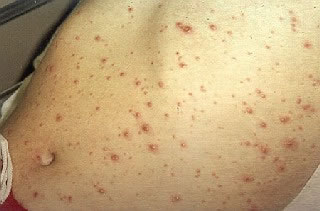
The Chickenpox rash can occur on all body surfaces. The rash is raised, red and itchy.
The rash is no longer contagious when all of the spots are crusted over and no new spots are appearing. This usually takes 7 days after the rash first appears.
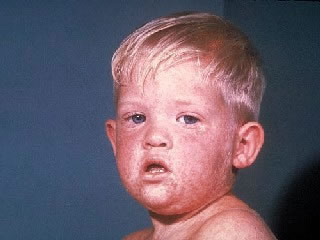
This photo shows a child with measles.
Measles is a very contagious disease. It is caused by a virus. Symptoms include fever, red eyes, runny nose, cough, and spots on the inside cheeks (inside of mouth). A red, blotchy rash appears around day 3 of the illness. It first appears on the face and then spreads to other areas.
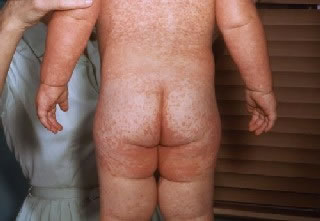
This child with measles is showing the common red blotchy rash on his buttocks and back. It is the 3rd day of the rash.
Measles is a very contagious viral disease. Symptoms include fever, red eyes, runny nose, cough, and spots on the inside cheeks.
A red blotchy rash appears around day 3 of the illness, first on the face, and then on other areas.
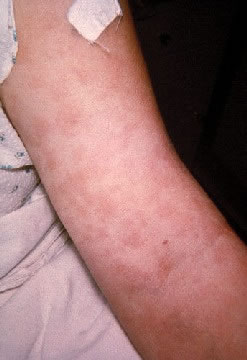
This patient had a widespread rash from an allergy to penicillin. The picture shows the arm.
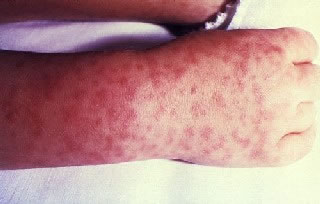
This child's right hand and wrist show the spotted rash of Rocky Mountain spotted fever.
Rocky Mountain spotted fever is caused by a bacteria. The disease is spread by ticks.
Copyright 2000-2023. Schmitt Pediatric Guidelines LLC.